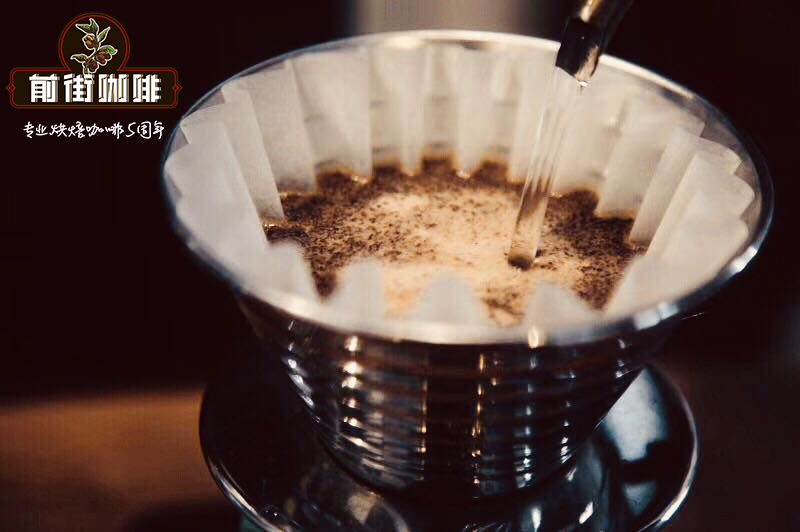What's the taste of coffee? does coffee taste good? there are several flavors of coffee.

Professional coffee knowledge exchange more coffee bean information please follow the coffee workshop (Wechat official account cafe_style)
Coffee is bitter, and many people think that the bitterness in coffee comes from caffeine.
In fact, roasted coffee beans will produce a continuous reaction, the chlorogenic acid in the coffee beans will be converted into chlorogenic acid lactone, which will continue to deepen the baking degree, and then will be decomposed into phenyl dihydrogenated indene.
Chlorogenic acid lactone can produce moderate bitterness in medium and light roasted coffee, and being decomposed into phenyl dihydroindene is the root cause of the bitterness in coffee.
The aroma and taste of coffee are produced after roasting. In the process of baking, the moisture of raw coffee beans is slowly released, the weight is reduced, the color deepens, the volume expands, and the aromatic oil is slowly released.
If you want to make your own coffee, just buy coffee beans. In addition to the aroma, coffee beans last nearly twice as long as coffee powder.
Coffee beans are the most complete form to preserve the flavor of coffee and ensure that the coffee is fresh and original.
Body: the taste of coffee in the mouth, from light as water or skim milk to thick as milk or cream, syrup.
Aftertaste: similar to the concept of wine tasting, refers to the taste that remains in the mouth after drinking coffee. Some coffee has the aftertaste of cocoa or chocolate, while others have fruit, berries, nuts and so on.
Balance (balance): this is an assessment of the overall taste of coffee. Good beans have a balanced, layered, and soft aroma, while bad beans usually show a single flavor.
Acidity (acidity): the stimulation felt at the edge of the tongue when drinking coffee. Unlike the acid of lemon, coffee is a refreshing, refreshing feeling that boosts the taste, sometimes called brightness. Acidity is a very important characteristic of coffee, coffee without acidity will be very insipid.
Aroma: the aroma of brewed coffee is more varied than that felt by the tongue. The adjectives commonly used to describe the aroma of coffee are fruit-like, earthy, smoky, flowery, berries, nuts and so on.
French baking (French roast): bitter, strong, not sour, with smoky aroma.
Italian roast: beans are glossy, bitter and scorched, and are mainly used to make espresso.
You can get the basic knowledge of identifying coffee beans from the above introduction, and find out your favorite taste by actually tasting different flavors of coffee beans. After reading this article, congratulations on entering the world of coffee. Let us repeat that a good coffee bean is the beginning of a good cup of coffee.
Very shallow baking (light roast): has a strong smell of grass, lack of aroma, rarely used for tasting.
Light roasting (cinnamon roast): high acidity, slightly fragrant, often used to make American coffee.
Medium roasting (medium roast): sour and bitter taste, moderate aroma, retain the original flavor of coffee beans, often used to make American coffee or mixed coffee.
Medium and deep baking (high roast): the taste is rich, sour and bitter balanced and slightly sweet, with good aroma and flavor.
Urban roasting (city roast): lower acidity than medium and deep roasting, perfect display of coffee flavor, is the standard roasting degree, the most popular among the general public.
Deep roasting (full city roast): bitterness is stronger than sour taste, the aftertaste is sweet, full of aroma, mostly used to make iced coffee or black coffee.
There are many ways to make Irish coffee. Find a coffee cup, fill the bottom with a spoonful of brown sugar, add some Scotland or Irish Whiskey to it because of your personal preference, and then fill the cup with hot coffee. Finally, float the coffee with whipped cream.
Coffee milk refers to coffee-flavored milk, similar to chocolate milk, the main difference is that instead of chocolate milk, coffee pulp is used.
Two very good coffees, Italian cappuccino and Greek Farabe, are mixed together to form a cappuccino. At Starbucks, Fabricio is sold as an iconic blend of coffee. To put it simply, it is the "star" of coffee.
The name Vietnamese iced coffee is only to show its Vietnamese "ancestry". To make this iced coffee, you have to use a good dark freshly ground coffee grown in Vietnam, cook it separately, use a small French drip filter made of metal, filter into the cup, add half the amount of sweetened condensed milk, stir it, and add a little ice. Coffee was brought into Vietnam by French colonists, so the French flavor of Vietnamese coffee is very strong.
Greek coffee, or Turkish coffee as it is called in Turkey, is made from coffee beans that are properly roasted, not overroasted. The secret of this coffee powder lies in the grinding of coffee beans. In a coffee factory, coffee beans must be ground hard. One thing to note about this kind of coffee is that when drinking coffee, there will be a thick layer of coffee foam at the bottom of the cup.
Greek coffee is slightly different from Turkish coffee. Greek coffee is more like Brazilian coffee and chicory coffee, mellow, smooth, but not so strong. Turkish coffee is a bit similar to Colombian coffee, more intense.
Marochino Coffee, also known as Moroccan Coffee, was created in Italy, not in Morocco, as most people associate with its name. Have some espresso in the small glass, add some cocoa and milk foam, and you can drink it. There is no doubt that this coffee tastes sweeter and softer than regular espresso.
Perhaps the most popular coffee in Italy is cappuccino, and it is also a true symbol of Italian drinks. Every self-respecting Italian drinks at least one cappuccino every week (not every day).
In general, cappuccino is made of espresso with hot milk and steamed milk. People are used to drinking cappuccinos from porcelain cups. Porcelain cups are more warm than glasses or paper cups. The milk foam layer on the coffee has an isolation effect and keeps the temperature continuously, which makes the heat of the coffee last longer.
Iced coffee is made from instant coffee powder, with a layer of milk foam floating on it. This is Farabe. This kind of coffee is very popular in Greece and Cyprus and has now spread to other countries.
Especially in recent years, Farabee is very popular in New York and Melbourne, thanks to the arrival of a large number of Greek immigrants in these cities. This is a very popular summer drink. For super coffee drinkers, it is definitely a pleasure to have a cup of Farabei in muggy weather.
Using the traditional French way to add milk to the coffee is the coffee Olei. The secret to making this kind of French coffee lies in coffee beans.
Espresso is the exact opposite of cappuccino. Espresso is suitable for those in a hurry, who are in a hurry and need high doses of caffeine to wake themselves up and start their day full of energy.
The main distinguishing point for this type of coffee is its size and length. The size is divided into single espresso, double espresso and three espresso, with small espresso, medium espresso and extended espresso in length. Correspondingly, the former refers to the amount of espresso in the same cup, while the latter refers to the amount of time it takes to extract coffee. If anyone is a big fan of strong pure bitter coffee, he is sure to fall in love with the good espresso.
For more professional coffee exchanges, please follow Wechat: FrontStreetCoffee
Professional coffee knowledge exchange more coffee bean information please follow the coffee workshop (Wechat official account cafe_style)
Important Notice :
前街咖啡 FrontStreet Coffee has moved to new addredd:
FrontStreet Coffee Address: 315,Donghua East Road,GuangZhou
Tel:020 38364473
- Prev

The four knowledge points of cappuccino how to make cappuccino the origin and classification of cappuccino name
Professional coffee knowledge exchange more coffee bean information Please pay attention to coffee workshop (Wechat official account cafe_style) Coffee is a favorite drink in people's daily life, many people's work and study begins with a cup of coffee. There are many kinds of coffee, among which cappuccino coffee is very popular. Today, I would like to introduce the fourth of Puccino.
- Next

The reason for the oil out of coffee beans is the oil on the surface of hand-washed coffee beans not fresh?
Professional coffee knowledge exchange more coffee bean information Please follow the coffee workshop (Wechat official account cafe_style) many coffee books will say: "if the coffee bean oil is no longer fresh -"; Ladies and Gentlemen! If you are more careful, you will find that these books come from a large number of sources.
Related
- Beginners will see the "Coffee pull flower" guide!
- What is the difference between ice blog purified milk and ordinary milk coffee?
- Why is the Philippines the largest producer of crops in Liberia?
- For coffee extraction, should the fine powder be retained?
- How does extracted espresso fill pressed powder? How much strength does it take to press the powder?
- How to make jasmine cold extract coffee? Is the jasmine + latte good?
- Will this little toy really make the coffee taste better? How does Lily Drip affect coffee extraction?
- Will the action of slapping the filter cup also affect coffee extraction?
- What's the difference between powder-to-water ratio and powder-to-liquid ratio?
- What is the Ethiopian local species? What does it have to do with Heirloom native species?

